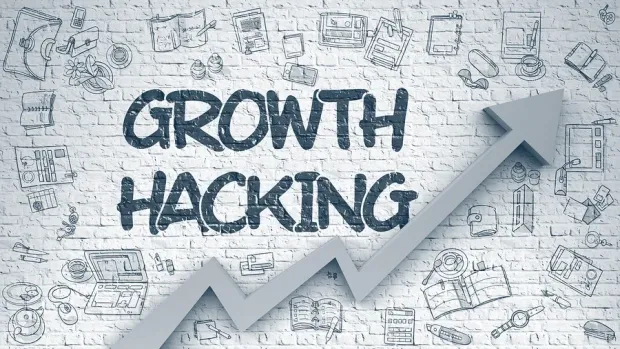The market is saturated with SaaS companies offering tonnes of services. Consumers have hundreds of options to choose from. In such a case, it is not enough to just market your product and software to the consumers.
The time calls for not marketing harder but smarter. Long-term campaigns planned to the dot don't provide enough results to warrant the efforts they require. Instead, planning short-term goals which are not extensively planned but are based on the current data offers better results.
To attract traffic and increase interaction with potential consumers, your product not just needs to have a solid online presence. It should also offer something that the consumers can relate to. It was surveyed that 78% of consumers are more likely to buy a service that provides personalized content.
What Is Growth Hacking
When Sean Ellis first used the term growth hacking back in 2010, people had difficulty understanding how it differed from usual marketing techniques.
Every online business and SaaS look for strategies that can gain millions of users in the least amount of time so that they can skyrocket their revenue. Growth hacking provides out-of-the-box solutions to achieve this aim. Most start-ups these days look for a growth hacker in their time.
Growth hacking works to provide only one aim: growth. They implement plans that cannot be customarily classified as marketing. They study the market, survey the consumer base, notice the current trends, and implement them into a short-term plan.
Growth hackers are technologically smart. They have a complete understanding of website designing and management, HTML and CSS, search engine optimization, content marketing, and other such skills.
The reason why start-ups these days prefer a growth hacker instead of a traditional marketer for their business is because growth hackers implement plans that can work even under a tight budget. These short-term plans are not honed to perfection but are implemented to judge consumers' potential and reactions.
Thus, B2B Identity growth hacking can be concisely explained as a marketing strategy that is focused solely on growth and works to achieve it with the help of all possible means and resources.
The Growth Hacking Funnel: Key Metrics to Measure
The growth hacking process called the AAARRR funnel has proven to be a boon to various businesses, from start-ups to large-scale companies. The growth of the hacking funnel includes six stages, abbreviated as AAARRR.
It stands for Awareness, Acquisition, Activation, Revenue, Retention, and Referral. These steps are detailed below.
- Awareness
The first stage of any marketing plan, even the most traditional one, has always been brand awareness. People need to know about your product or services for them to be convinced to buy them. This step is especially essential for SaaS growth marketing, as without digital awareness over social media and traffic, the product has no chance of surviving in the market.
- Acquisition
Now that your services have attracted the eyes of the potential customer, the next step is to study customer behavior. Under this process, a database for each user is created so that the trend followed by each user can be recorded and judged.
Through the acquisition of data, one can determine how to modify their product to suit different customers' needs and personalize the experience for them.
- Activation
Activation is the stage when the customer interacts with the website and the product offered. This is an onboarding process where you can ensure the customer feels that you are providing a solution to their problem. For example, a user needs to access foreign language shows with proper subtitles. They find your website that offers subtitled and dubbed versions of various foreign shows and movies.
- Retention
Any business manager knows that retaining existing users is much easier than attracting a new one. Not only will you have to invest more money in advertising campaigns, but also you will have to provide them with offers and free services for their investment towards your services.
Maintaining retention rate is much easier than raising conversion rates. This can be done through new offers, better content and services, events, and other such engaging features.
- Referral
This is where conventional marketing lags behind growth hacking. SaaS and other digital businesses have adopted the word-of-mouth technique to make it suitable for an online era. Through referrals, you can get free marketing for your product. Not only that, as the number of referrals grows, it proves that consumers trust and respect your services and are willing to share them with more people.
- Revenue
Revenue is what remains after the cost that you invested in the acquisition of the customers. CAC or customer acquisition cost is a direct indicator of lifetime value. The business needs to aim for a lower CAC and a higher lifetime value to ensure considerable revenue.
Beginner's Guide to Start With Growth Hacking
Growth hacking has become an essential factor in a start-up or business marketing to ensure that it can kick start earning revenue. However, the question lies in how to begin. The very first step that you need to take is to study your target consumer.
You should also know the problem that your product or service is addressing. Here are the steps you can take to implement growth hacking in your business.
- Target your market
Your product should provide a direct solution to the problem. The process called product-market fit helps you identify the market demand and ensure that your services provide a superior and more accessible solution.
- Identify goals
As you kickstart your business, set specific goals that you aim to achieve. For example, set a five-year goal broken into shorter goals that are to be achieved half-yearly and yearly.
- Analyse Data
Growth hacking is based on analyzing data and implementing tasks based on the results. The data will dictate the prospect of the company. For example, if a SaaS company has a retention rate of more than 35% then it is considered faring well.

- Get Feedback
Once you have begun marketing your product, ask your customers about their thoughts and feedback for it. Understand what they like to integrate it and remove the parts and features that are unnecessary.
- Reevaluate
Once you have analyzed the data and gathered the feedback from the potential user base, re-examine your strategy and tune it to appease the consumers' current needs.
Difference Between Growth Hacking and Traditional Marketing
Growth hacking has one goal, growth. Traditional marketers focus on advertising campaigns that are usually long-term. Growth hackers, on the other hand, implement short-term experiments to study which technique works.
Technical growth hacker tend to know more about the business's technical side and apply their knowledge while creating and planning the experiments. As they have to study the interaction and retention of the customers, they need to know every aspect of the product or service.
5 Powerful Growth Hacking Strategies
SaaS growth hacking strategies may take some time to show results, but if applied correctly, they can boost the company's growth in the long run.
- Free Trials
One of the most trusted and successful growth marketing strategies followed by top SaaS companies such as Netflix is offering free trials. If you provide a helpful service, offering it for free on an invite-only basis is a sure-shot way to attract an audience.
- Referrals
Another long-running and successful strategy is offering free trials. Referrals have been the backbone of marketing strategies of companies such as Dropbox and Hotmail. 92% of people tend to believe the word of their family rather than advertisements.
- Customer Service
A basic marketing strategy that most people end up ignoring while launching their product. You need data to improve your growth marketing strategy. Prompt customer service will not only appease the consumers but also provide you with essential feedback.
- Email List and Follow-Ups
Maintain an email list of the people that interacted with your product and website. Also, ensure that you follow up on past consumers who interacted with the product in the past. Provide them similar content through blog posts or new offers so that they know that you care and appreciate them.
Some Examples of Growth Hacking
- Hotmail's love
Hotmail's strategy was deemed to be unconventional at the time. It added the sentence "PS I love you" to their emails. People who received the mail could click on the sentence, and they would be redirected to Hotmail's website. Here, when they saw that Hotmail provides its services for free, most people switched to Hotmail.
- Dropbox's free space
Another one of the case studies of growth hacking is Dropbox. It offered 16 GB of free space when a user invited someone to Dropbox. The referral services were the reason the number of users skyrocketed in a couple of months.
Growth hacking is not a string of strategies that can be taught. It won't be wrong to call it a mindset one gains when their only focus is the business's growth. With affordable techniques suitable even for start-ups and analysis of the data, one can achieve millions of users in the least period.



